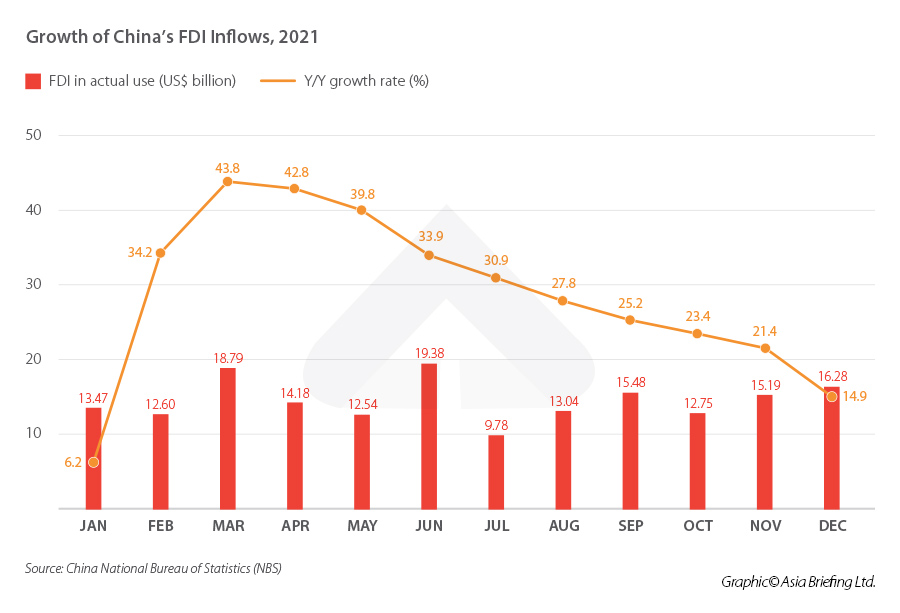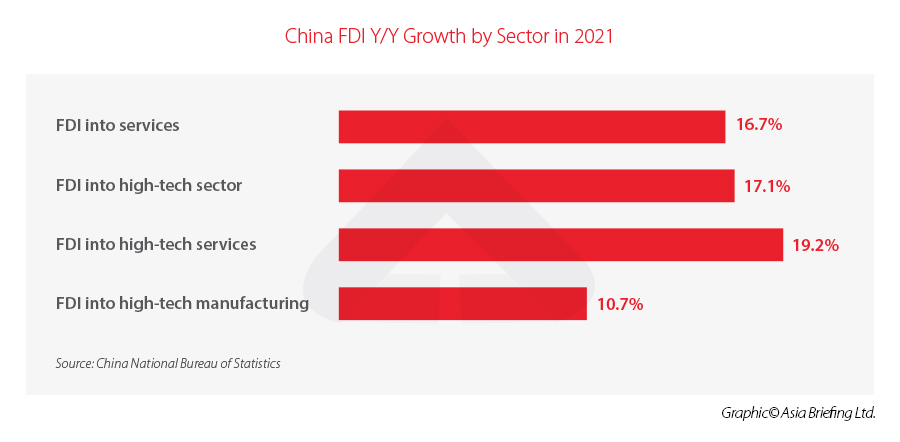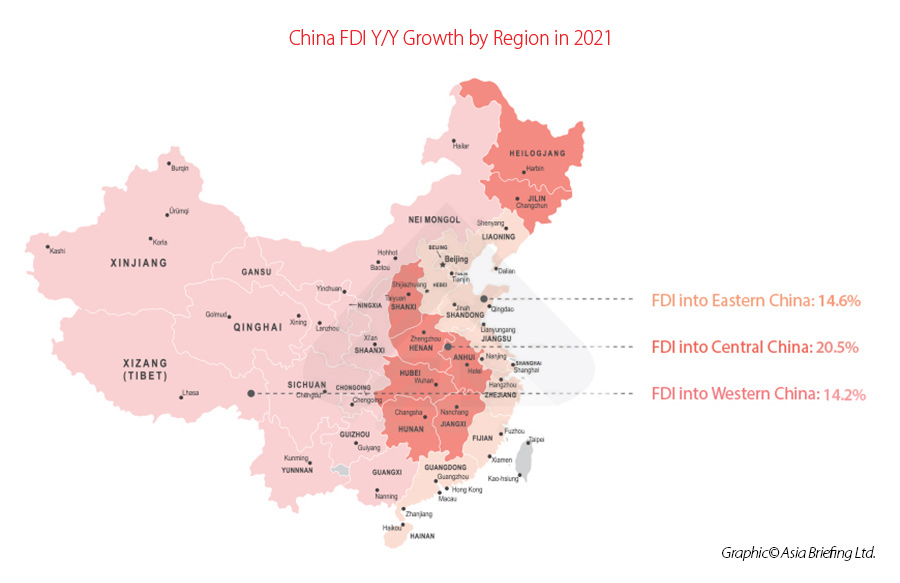China’s FDI Hit Record High, Global FDI Rebounds in 2021
China saw record high FDI inflows topping RMB 1 trillion last year, driven by strong services FDI. The robust double-digit growth is considered remarkable amid the ongoing global pandemic and heightened geopolitical tensions, reflecting foreign companies’ growing confidence in China’s sound economic fundamentals and constantly improving business environment. China’s FDI inflows from RCEP member countries are expected to jump this year as the agreement takes effect from January 1, 2022.
In 2021, China’s actual use of FDI hit RMB 1.149 trillion, representing a 14.9 percent surge from the previous year. In US dollar terms, the FDI inflows came in at US$173.48 billion, up 20.2 percent year on year, according to the Ministry of Commerce (MOFCOM).
For comparison, in the COVID-ravaged year of 2020, FDI into Chinese mainland stood at RMB 1.034 trillion, up 7.4 percent year-on-year. In US dollar terms, it totaled US$149.34 billion, up by 5.7 percent, according to the Statistical Bulletin of FDI in China released by MOFCOM in November 2021.
The robust double-digit growth last year is considered remarkable on a relatively high base in 2020 – China registered positive growth of 5.7 percent at a time when global FDI plunged 34.7 percent.
As to the number of foreign-invested enterprises (FIEs), about 48,000 were registered in 2021, up 23.5 percent year on year. This continues the recovery from a slump in 2019 that saw the figure drop to 40,910 from 60,560 in 2018.
Global FDI rebounds in 2021, China still accounts for a fair share
China had remained as the world’s second biggest FDI recipient for four years in a row, from 2017 to 2020, only after the US, according to MOFCOM. It even narrowed the gap that year when the US saw a sharp drop from US$261 billion to US$156 billion in FDI inflows due to the pandemic.
In 2020 when global FDI saw a deep decline, China’s actual use of FDI accounted for about 15 percent of the global total, up from the 6.7 percent recorded in 2015.
In 2021, overall global FDI flows showed a strong rebound, up 77 percent to reach an estimated US$1.65 trillion, and surpassing pre-pandemic levels, according to the United Nations Conference on Trade and Development (UNCTAD). China’s share of global FDI flows is expected to fall back somewhat, as FDI in most economies rebounded, among which FDI flows into the US more than doubled and into ASEAN countries increased 35 percent.
A closer look at China’s FDI inflows in 2021
FDI jump into the service industry and high-tech sectors
China’s robust FDI growth in 2021 was powered by strong investment in services and high-tech sectors.
The total FDI inflow into the service sector increased 16.7 percent, year-on-year, to RMB 906.49 billion (US$142.77 billion).
High-tech FDI continued to outperform, with the sector seeing FDI inflows jump 17.1 percent from a year earlier, measured in Chinese yuan. Of it, high-tech manufacturing rose 10.7 percent, and high-tech services grew 19.2 percent.
The MOFCOM didn’t reveal data for manufacturing FDI in 2021. Manufacturing FDI trends are likely to remain flaccid, dampened by ongoing investment diversion into bolster supply-chain security, according to Fitch Ratings.
FDI growth into China’s central regions went up
FDI growth into eastern and western China were reported at similar levels, while China’s central region saw a relatively faster rate of FDI inflow.
In 2021, the FDI actually used in China’s eastern, central, and western regions climbed by 14.6 percent, 20.5 percent, and 14.2 percent year-on-year, respectively.
FDI from BRI and ASEAN countries jumped
Investment into the Chinese mainland from countries along the Belt and Road Initiative (BRI) and the Association of Southeast Asian Nations (ASEAN) jumped 29.4 percent and 29 percent, respectively.
Fitch Ratings in November 2021 projected the total FDI in China would see more inflow from the 14 member countries of the Regional Comprehensive Economic Partnership (RCEP), which takes effect this year.
RCEP member countries, which include Singapore, South Korea and Japan, together accounted for 42 percent of China’s total FDI in 2020, excluding Hong Kong and Macao (a large portion of inflow from Hong Kong and Macao is originated by Chinese companies).
How Chinese policymakers plan to promote FDI in 2022?
As the COVID-19 pandemic, the volatile political environment, and rising input costs continue to post challenges, the Chinese government has pledged to stabilize FDI and foreign trade this year.
At a press briefing held on January 25, Chen Chunjiang, Director-General of the Commerce Ministry’s Department of Foreign Investment Administration, said that China will step up efforts to open up its market and optimize support measures this year.
China will ensure the implementation of the 2021 version of negative lists for foreign investment. The national and free trade zone (FTZ) negative lists updated in 2021 reduced the number of sectors in which foreign investors are restricted or prohibited. Among others, the lists removed limits on foreign ownership in passenger-car makers.
The government will also expand the catalogue of industries encouraging foreign investment, leveraging preferential policies on land and taxation to lure more foreign capital into advanced manufacturing, modern services, high-tech sectors, low-carbon and green industries, digital economy, and in the central and western regions.
China will also promote the RCEP’s entry into force this year, and allow an unprecedented level of access to its markets in a bid to join the Comprehensive and Progressive Agreement for Trans-Pacific Partnership (CPTPP).
Chen also promised that China would further optimize its business environment, ensure effective enforcement of the foreign investment laws and regulations, the establishment of the complaint mechanism for FIEs, the protection of intellectual property rights (IPRs), and equal treatment for domestic and foreign companies.
About Us
China Briefing is written and produced by Dezan Shira & Associates. The practice assists foreign investors into China and has done so since 1992 through offices in Beijing, Tianjin, Dalian, Qingdao, Shanghai, Hangzhou, Ningbo, Suzhou, Guangzhou, Dongguan, Zhongshan, Shenzhen, and Hong Kong. Please contact the firm for assistance in China at china@dezshira.com.
Dezan Shira & Associates has offices in Vietnam, Indonesia, Singapore, United States, Germany, Italy, India, and Russia, in addition to our trade research facilities along the Belt & Road Initiative. We also have partner firms assisting foreign investors in The Philippines, Malaysia, Thailand, Bangladesh.
- Previous Article Belt and Road Weekly Investor Intelligence #66
- Next Article 2021 China Demographic Trends – What the Latest Data Says













